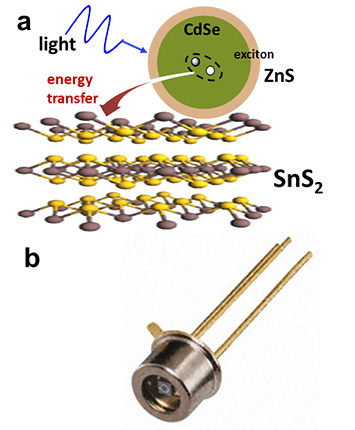Nanomaterial Composites Greatly Enhance the Efficiency of Photodetectors
May 1, 2016
What Is The Scientific Achievement?
A novel hybrid material has been developed that combines zero dimensional (0D) cadmium selenide/zinc sulfide (CdSe/ZnS) quantum dots and stacked, two dimensional (2D) nanoscale sheets of tin sulfide (SnS2). This hybrid materials system possesses an unexpectedly improved photoelectric response (a substantial increase of over 500%) compared with that of either CdSe/ZnS quantum dots or SnS2 sheets by themselves.
Why Does This Matter?
When incorporated in a field effect transistor (FETs), the hybrid materials’ substantially increased photocurrent response was due to an energy transfer process between the 0D and 2D constituents. This synergistic approach of sensitizing the SnS2 nanosheets by quantum dots provides a promising route for developing highly efficient energy-harvesting composites, which can be broadly exploited in applications, such as photo-detector devices and solar panels.
What Are The Details?
Emerging 2-D semiconductors, especially layered metal dichalcogenides (LMDs) such as MoS2, WS2 and WSe2 have shown great potential applications in photocatalysis, photon detectors and energy harvesting. These materials show band structure dependence on the number of layers and band-gap inversion at monolayer with intense visible photoluminescence, making them interesting candidates for photo sensing applications.
 enlarge
enlarge
a) Schematic showing the interaction between the SnS2 nanosheets and a CdSe/ZnS QD via energy transfer from the exciton in the QD. b) These hybrid composites could have a significant impact on the performance light harvesting efficiency of sensitized photodetectors.
CFN Capabilities: CFN’s Materials Synthesis and Characterization Facility was used to fabricate and to characterize the electrical properties of the hybrid FET devices. CFN’s Advanced Optical Spectroscopy and Microscopy Facility was used to perform time-resolved photoluminescence characterization on the hybrid nanomaterials system.
Publication Reference
Nonradiative Energy Transfer from Individual CdSe/ZnS Quantum Dots to Single-Layer and Few-Layer Tin Disulfide
Huidong Zang,†,⊥ Prahlad K. Routh,†,‡,⊥ Yuan Huang,†,⊥ Jia-Shiang Chen,†,‡ Eli Sutter,§ Peter Sutter,*,? and Mircea Cotlet*,†,‡
†Center for Functional Nanomaterials, Brookhaven National Laboratory, Upton, New York 11973, United States
‡Materials Science Department, Stony Brook University, Stony Brook, New York 11794, United States
§Department of Mechanical and Materials Engineering and ?Department of Electrical and Computer Engineering, University of Nebraska-Lincoln, Lincoln, Nebraska 68588, United States
ACS Nano 10, 4790 (2016) &
Hybrid quantum dot-tin disulfide field-effect transistors with improved photocurrent and spectral responsivity
Yuan Huang,1,a) Huidong Zang,1,a) Jia-Shiang Chen,1,2 Eli A. Sutter,3 Peter W. Sutter,4,b) Chang-Yong Nam,1, and Mircea Cotlet1,2
1 Center for Functional Nanomaterials, Brookhaven National Laboratory, Upton, New York 11973, USA
2 Department of Materials Science and Engineering, Stony Brook University, Stony Brook, New York 11794, USA
3 Department of Mechanical and Materials Engineering, University of Nebraska-Lincoln, Lincoln, Nebraska 68588, USA
4 Department of Electrical and Computer Engineering, University of Nebraska-Lincoln, Lincoln, Nebraska 68588, USA
Applied Physics Letters 108, 123502 (2016).
Acknowledgement of Support:
Research carried out at the Center for Functional Nanomaterials, Brookhaven National Laboratory, which is supported by the U.S. Department of Energy, Office of Basic Energy Sciences, under Contract No. DE-SC0012704.
2016-6630 | INT/EXT | Newsroom









